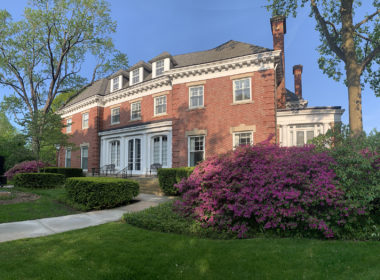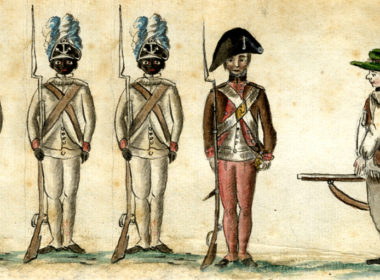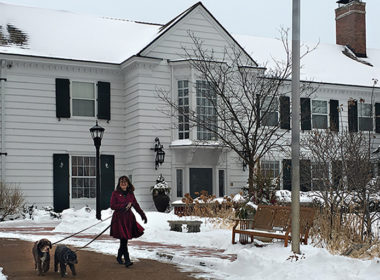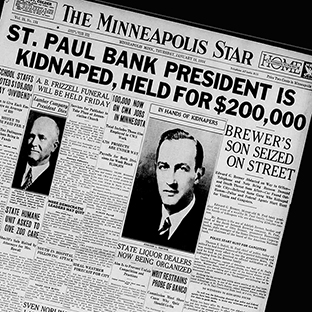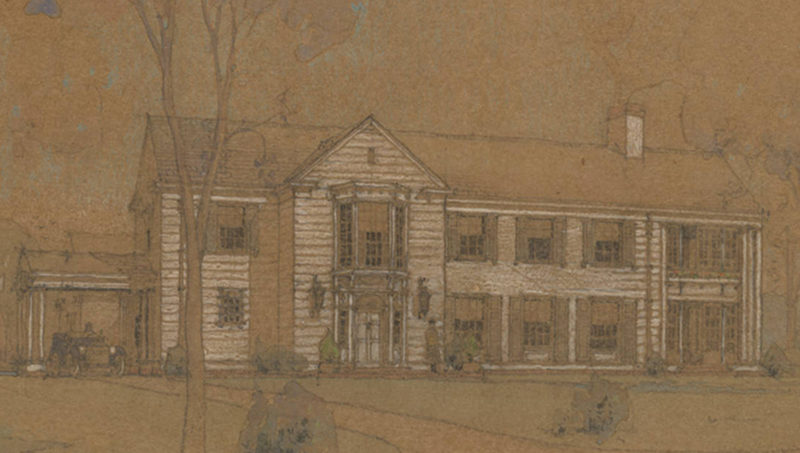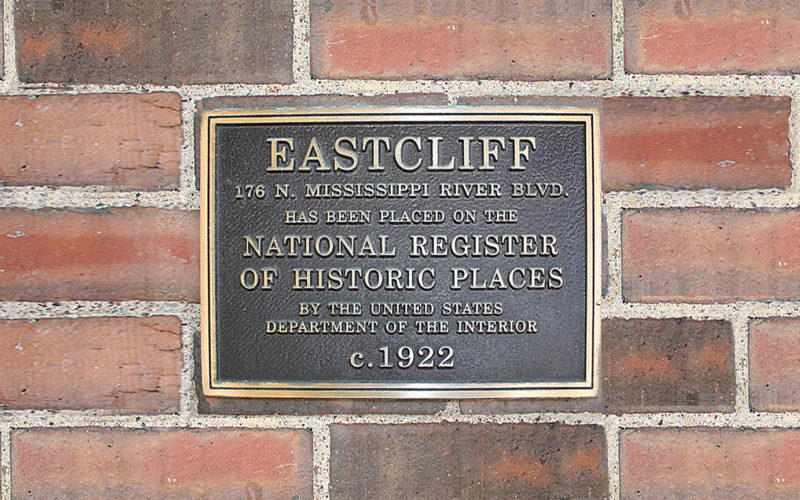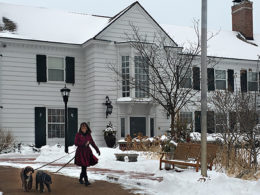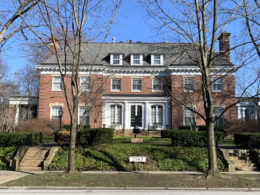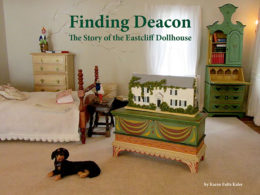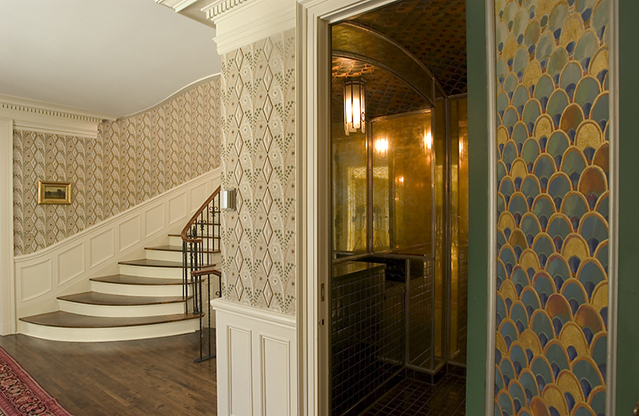
Photo courtesy of the University of Minnesota
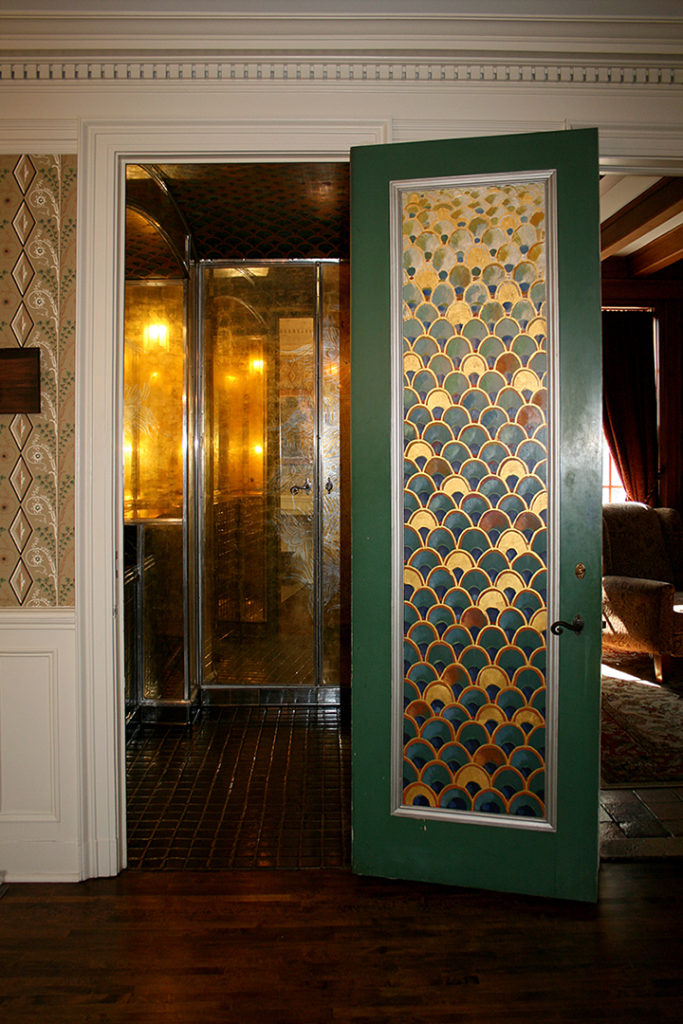
Was the Eastcliff peacock room once a prohibition-era hidden bar? (Read Eastcliff: History of a Home to discover the truth.) The peacock room is, without a doubt, the scene of gangster stories in Eastcliff: History of a Home.
The gangster period was a fascinating chapter in St Paul’s history. Most significant for Eastcliff was the kidnapping of Edward Bremer, who lived just three houses south of Eastcliff at number 92 on the boulevard. In telling that story in Eastcliff, I am indebted to Paul Maccabee’s book, John Dillinger Slept Here: A Crook’s Tour of Crime and Corruption in St. Paul, 1920–1936, for the detailed history that inspired me to do more research. Following are a few details about the Eastcliff neighborhood that were cut from the Eastcliff book.
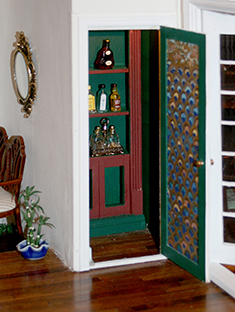
Photos of the peacock room and the peacock room in the Eastcliff dollhouse, by Karen Kaler.
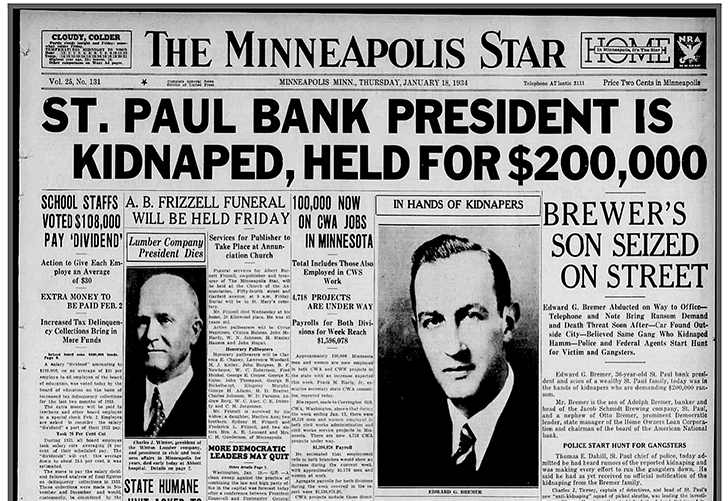
The Minneapolis Star, January 18, 1934
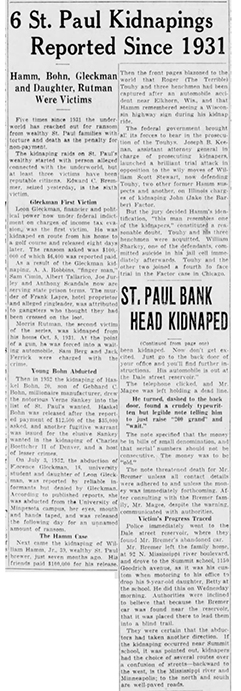
Edward Bremer, who survived but was traumatized by the kidnapping, had a young daughter, Betty, who was a classmate of Binky Brooks. A January 20, 1934, St. Cloud newspaper, the Daily Times and Daily Journal, reported that Betty had returned to school on Friday, missing just one day following the Wednesday kidnapping. “Reliable sources close to the family said she had not been told her father had been kidnaped [sic] and threatened with death; nor that he might be seriously injured, or worse, following the finding of Bremer’s automobile, the interior profusely blood splotched, a few hours after he had left his daughter at the school Wednesday morning.”
One of the keys to solving the Bremer kidnapping was a discarded gas can. According to bank robber and kidnapper Alvin Karpis, while “running the roads” to plan crimes, such as the Bremer kidnapping, the plotters would stash cans of gas along their chosen routes “since cops had the nasty habit of shooting holes in our tanks as we drove away from the scenes of our crimes.” They also carried corks to plug holes in their gas tanks.
Source: Alvin Karpis with Bill Trent, The Alvin Karpis Story (New York: Coward, McCann and Geoghegan, Inc., 1971), 19.
“6 St. Paul Kidnapings Reported since 1931” article from The Minneapolis Star, January 18, 1934
Edward Bremer’s daughter, Betty
The Minneapolis Star Tribune, December 14, 1952
Betty Bremer grew up, graduated from Wellesley, and became president of the Minneapolis and St. Paul Wellesley Club. When she married in 1952, her reception was at the Town and Country Club, and her parents were still living on Mississippi River Boulevard. Betty and her husband also remained in St. Paul.
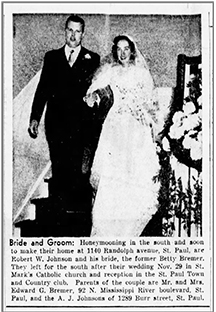
During the 1930s kidnappings, a child of a St. Paul lumber family was a kidnapping victim in Washington State. In May 1935, nine-year-old George Weyerhaeuser was kidnapped in Tacoma. (His grandfather founded the Weyerhaeuser Company and his uncle lived in St. Paul.) The ransom was paid, the child was returned, the kidnappers were caught and served lengthy prison terms, and much of the ransom money was recovered. Kidnapper Harmon Waley pled guilty in 1935. He wrote George Weyerhaeuser several apology letters from prison. When Waley was released from Alcatraz in 1963, Weyerhaeuser gave him a job.
Prior to the Bremer kidnapping, Leon Gleckman was kidnapped and held for eight days. The Gleckman home was at 2168 Sargent Avenue. (Margaret “Marney” Brown, who would grow up and marry Conley Brooks, lived as a child at 2184 Sargent Avenue, 200 feet east of the Gleckmans.) Leon Gleckman had a rivalry with Jack Peifer of the Hollyhocks Club.
The Hollyhocks Club was in one of the oldest buildings on Mississippi River Boulevard. Peifer ran the Hollyhocks Club as an elegant speakeasy during the early 1930s. It was known as a gangster hangout for members of the John Dillinger and Barker-Karpis gangs, among others.
Gleckman said he learned that people he knew were involved in his kidnapping. He said he would take care of them. Shortly after, one of the suspected kidnappers, Frank LaPre, was shot multiple times. Information obtained from LaPre before he died was allegedly used to identify and arrest the other kidnappers. No arrest was made in LaPre’s murder.
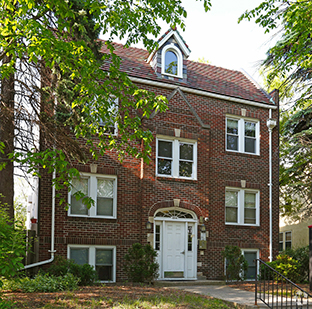
Town and Country Apartments
at 2214 Marshall Avenue near Eastcliff
A Dillinger weapons’ depot was in unit 106 of the Town and Country Apartments at 2214 Marshall Avenue.
Dillinger used a machine gun to shoot his way out of an FBI trap at another St. Paul apartment building.
Cle-Mar apartment building
at 2062 Marshall Avenue
In 1932, the Barkers (Arizona/Kate “Ma” Barker and the two youngest of her four criminal sons, Arthur “Doc” and Fred) lived as “the Gordons” in apartment 37 of the Cle-Mar apartment building at 2062 Marshall Avenue. They next moved to 1290 Grand Avenue. They left St. Paul after a source in the police department tipped them about an upcoming raid.
They robbed a bank in Nebraska, and then returned to St. Paul and lived at the Commodore Hotel in 1933. Al Capone also stayed there. (About ten years earlier, in 1921 and 1922, the Commodore Hotel had been frequented by Zelda and F. Scott Fitzgerald, and they lived there briefly. About 40 years later, in the late 1970s, the Malcolm Moos family lived there for a short while.) In 1933, the Barker-Karpis gang rented a house on Eagle Lake in White Bear Township while they planned the two St. Paul kidnappings that ended both their lives of crime and some of their lives.
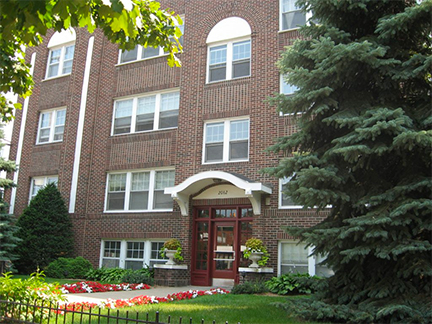
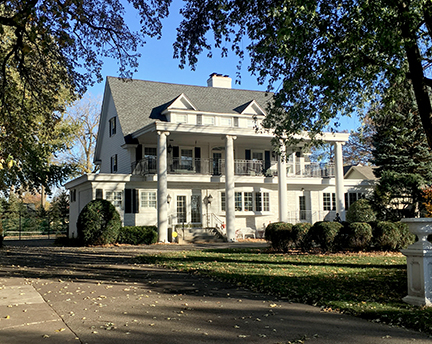
The Hollyhocks Club was a gangster hangout three miles south of Eastcliff on Mississippi River Boulevard. It is now a lovely private residence.
You will meet many remarkable women in the Eastcliff: History of a Home. Supposed “criminal mastermind” Arizona Clark “Ma” Barker is not one of them. While she was often living in hideouts with her sons, Doc and Fred, when they committed crimes, there is no evidence that she was a genius of any kind. Alvin Karpis, who considered Fred to be his best friend and her to be like a mother, wrote, “We’d leave her at home when we were arranging a job, or we’d send her to a movie. Ma saw a lot of movies. You only had to spend a few hours with Ma to see she wasn’t the criminal type. She was just an old-fashioned homebody from the Ozarks.” (Alvin Karpis with Bill Trent, The Alvin Karpis Story (New York: Coward, McCann and Geoghegan, Inc., 1971), 81.) Her legend began years after her death in order to explain how an old lady ended up riddled with FBI bullets.
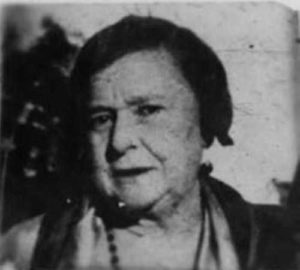
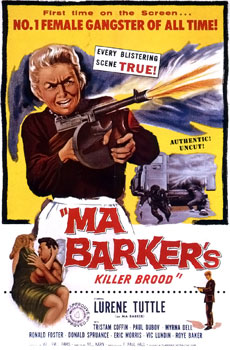
The Great Depression
Reading about the Brooks family in the 1930s, my husband asked a question that you may also have wondered about: How was the Brooks family effected by the severe worldwide economic depression which began in 1929? In Turning the Leaves, the family recounted the stress of the neighborhood kidnapping in 1931 and 1934. (These were crimes against very wealthy people.) They also reported the stress of World War II, as both Conley and Ted served.
In the first full year of the Depression, 1930, Edward and Markell added on to Eastcliff and bought property for a summer vacation home at Gull Lake. In 1933, they were on a cruise when they first met their friends Ed and Marion Austin. (A photo from the trip shows Markell, Ed, and Marion in Italy.) They were on another trip to Europe in 1934, and again in 1936.
It seems to me that the Brooks were little effected by the Depression. The family owned the largest newsprint mill in the world, Powell River in Oregon. In every Depression-era movie I recall, there are people selling newspapers along the streets. Newsprint was apparently a stable business during those years.
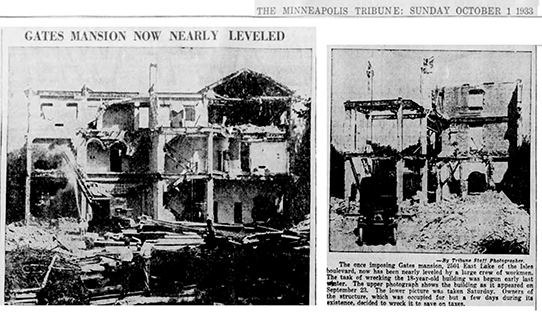
The Minneapolis Tribune, October 1, 1933
The Gates Mansion
In 1931, Edward’s father, Dr. Dwight Brooks, bought the Gates Mansion, on Lake of the Isles. The Gates Mansion was the largest house ever built in Minneapolis. Dr. Brooks bought it for less than ten percent of the cost to build it—but the house cost $60,000 per year to maintain. Dwight Brooks never lived, nor even spent a night, in the house. After he died, Edward Brooks could not sell the mansion, nor even give it away. It was torn down in 1933.
Markell Brooks gave Eastcliff to the University of Minnesota because she feared that if she sold it, the house would be torn down to build several houses on the big beautiful lot along the Mississippi RIver.
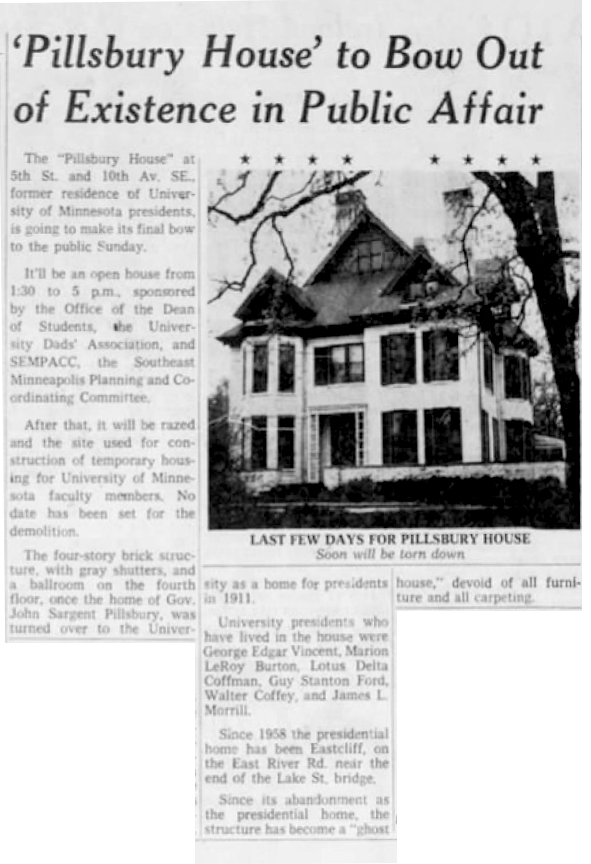
The Pillsbury Mansion
The Minneapolis Star, May 13, 1964
Eastcliff replaced the Pillsbury Mansion as the official residence of University of Minnesota presidents. The Pillsbury Mansion, like the Gates Mansion, was demolished.
Please note: The above text was edited from Eastcliff: History of a Home due to lack of space. It is intended as a supplement to the book, which has much more fascinating information.

